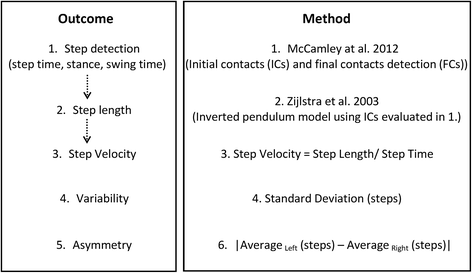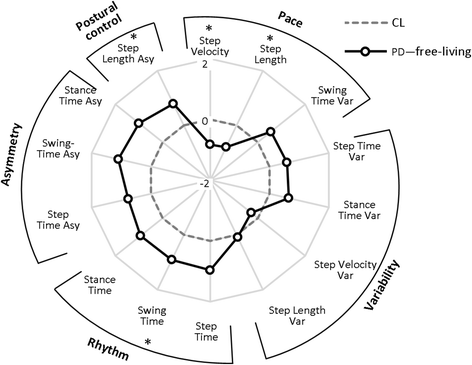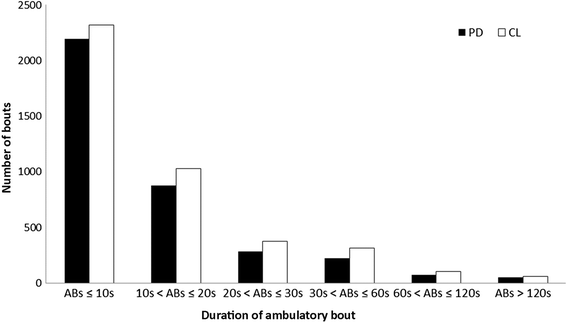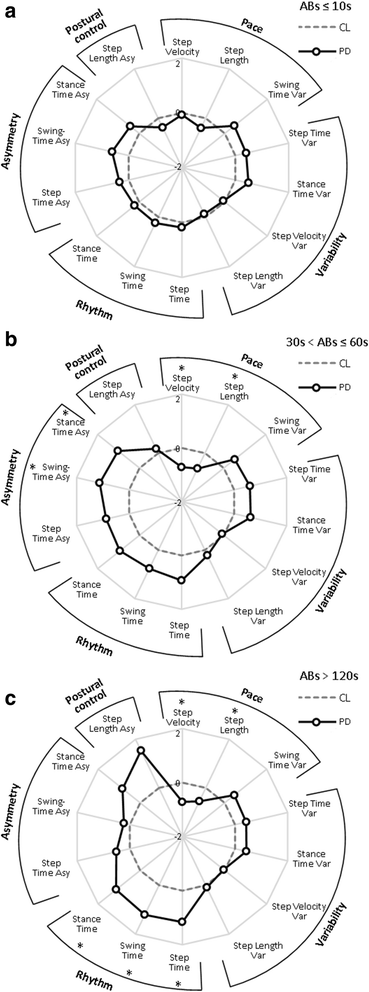Free-living gait characteristics in ageing and Parkinson's disease: impact of environment and ambulatory bout length
- PMID: 27175731
- PMCID: PMC4866360
- DOI: 10.1186/s12984-016-0154-5
Free-living gait characteristics in ageing and Parkinson's disease: impact of environment and ambulatory bout length
Abstract
Background: Gait is emerging as a powerful diagnostic and prognostic tool, and as a surrogate marker of disease progression for Parkinson's disease (PD). Accelerometer-based body worn monitors (BWMs) facilitate the measurement of gait in clinical environments. Moreover they have the potential to provide a more accurate reflection of gait in the home during habitual behaviours. Emerging research suggests that measurement of gait using BWMs is feasible but this has not been investigated in depth. The aims of this study were to explore (i) the impact of environment and (ii) ambulatory bout (AB) length on gait characteristics for discriminating between people with PD and age-matched controls.
Methods: Fourteen clinically relevant gait characteristics organised in five domains (pace, variability, rhythm, asymmetry, postural control) were quantified using laboratory based and free-living data collected over 7 days using a BWM placed on the lower back in 47 PD participants and 50 controls.
Results: Free-living data showed that both groups walked with decreased pace and increased variability, rhythm and asymmetry compared to walking in the laboratory setting. Four of the 14 gait characteristics measured in free-living conditions were significantly different between controls and people with PD compared to two measured in the laboratory. Between group differences depended on bout length and were more apparent during longer ABs. ABs ≤ 10s did not discriminate between groups. Medium to long ABs highlighted between-group significant differences for pace, rhythm and asymmetry. Longer ABs should therefore be taken into account when evaluating gait characteristics in free-living conditions.
Conclusion: This study provides encouraging results to support the use of a single BWM for free-living gait evaluation in people with PD with potential for research and clinical application.
Keywords: Accelerometer; Ambulatory activity; Body worn monitor; Free-living data; Gait; Parkinson’s disease.
Figures






References
-
- Weiss A, Brozgol M, Dorfman M, Herman T, Shema S, Giladi N, Hausdorff JM. Does the evaluation of gait quality during daily life provide insight into fall risk? A novel approach using 3-day accelerometer recordings. Neurorehabil Neural Repair. 2013;27:742–752. doi: 10.1177/1545968313491004. - DOI - PubMed
-
- Weiss A, Herman T, Giladi N, Hausdorff JM. New evidence for gait abnormalities among Parkinson’s disease patients who suffer from freezing of gait: insights using a body-fixed sensor worn for 3 days. J Neural Transmission (Vienna, Austria. 2015;122:403–410. doi: 10.1007/s00702-014-1279-y. - DOI - PubMed
MeSH terms
LinkOut - more resources
Full Text Sources
Other Literature Sources
Medical

